Tom's Guide Verdict
The Motorola Edge 5G UW challenges phones like the Samsung Galaxy A52 5G with an improved camera and fast charge times. The phone generally delivers, though there some quirks like a hit on battery life from its fast-refreshing display.
Pros
- +
108MP main camera takes good photos
- +
Good performance over other phones at this price
- +
Fast 30-watt charging
- +
Screen refresh rate maxes out 144Hz
Cons
- -
144Hz refresh rate hampers battery life
- -
Cameras sometimes struggle with color accuracy
- -
Lone speaker is easily muffled when gaming
Why you can trust Tom's Guide
Starting price: $549
Screen size: 6.8-inch FHD+ resolution
Maximum refresh rate: 144Hz
CPU: Snapdragon 778G
RAM: 6GB | 8GB (unlocked)
Storage: 128GB | 256GB (unlocked)
Rear cameras: 108MP main (f/1.9); 8MP ultrawide (f/2.2); 2MP depth sensor
Front camera: 32MP (f/2.25)
Battery size: 5,000 mAh
Battery life (Hrs:Mins): 11:38 (60Hz); 9:23 (144Hz)
Size: 6.7 x 3 x 0.35 inches
Weight: 7.1 ounces
The Motorola Edge 5G UW faces the same dilemma as last year's Motorola Edge — how to stand out from a sea of similarly priced phones. Motorola takes on this task by making some key improvements to the latest Motorola Edge — the main camera packs more resolution, the screen refreshes at a faster rate, and the phone charges faster than before — while keeping the price competitive.
Those kind of improvements generally help a phone break through a crowded field of options, and our Motorola Edge 5G UW review finds a device that's much improved over last year's model. You'll still have to overlook some particular quirks with the latest Motorola Edge, but otherwise, this is a solid rival to other top midrange models and a decent alternative to higher-priced flagships.
- Best Android phones: Which one should you buy?
- Find the best big phones
Motorola Edge 5G UW review: Price and availability
We're reviewing the Motorola 5G UW, a $549 phone with 6GB of RAM and 128GB of storage that's available through Verizon and works with that carrier's high-speed Ultra Wideband 5G network. You can buy the phone in 30 monthly installments of $18.33. Verizon is also offering the Motorola Edge 5G as a free device (via monthly credits on your bill) when you sign up for a select unlimited plan.
If you're not enamored with the idea of Verizon as your carrier, there's an unlocked version of Motorola Edge (2021) with 256GB of storage and 8GB of RAM available at a regular price of $699. This version lacks the Ultra Wideband connectivity, but it will work with other 5G networks; otherwise, there's no difference between these two Motorola Edge (2021) models.
To put the Motorola's phone price in context, Apple's iPhone 13 mini costs $699 while Samsung's Galaxy S20 FE has fallen to $599. The midrange Galaxy A52 5G costs $499, so the Motorola Edge 5G UW falls squarely between a lower-end flagship and an upper-midrange model.
Motorola Edge 5G UW review: Design
With its Nebula Blue back panel shimmering in the light, the Motorola Edge 5G UW looks deceptively fancy, especially when the light catches the back of the phone and reflects on the 6.7 x 3 x 0.35-inch device. But once you pick up the Edge, you know why it costs less than the premium phones it tries to emulate — that's a plastic back meant to evoke fancier phones. The Motorola Edge can pick up fingerprints through regular use, though I've used phones in this price range that have done a worse job at hiding smudges.
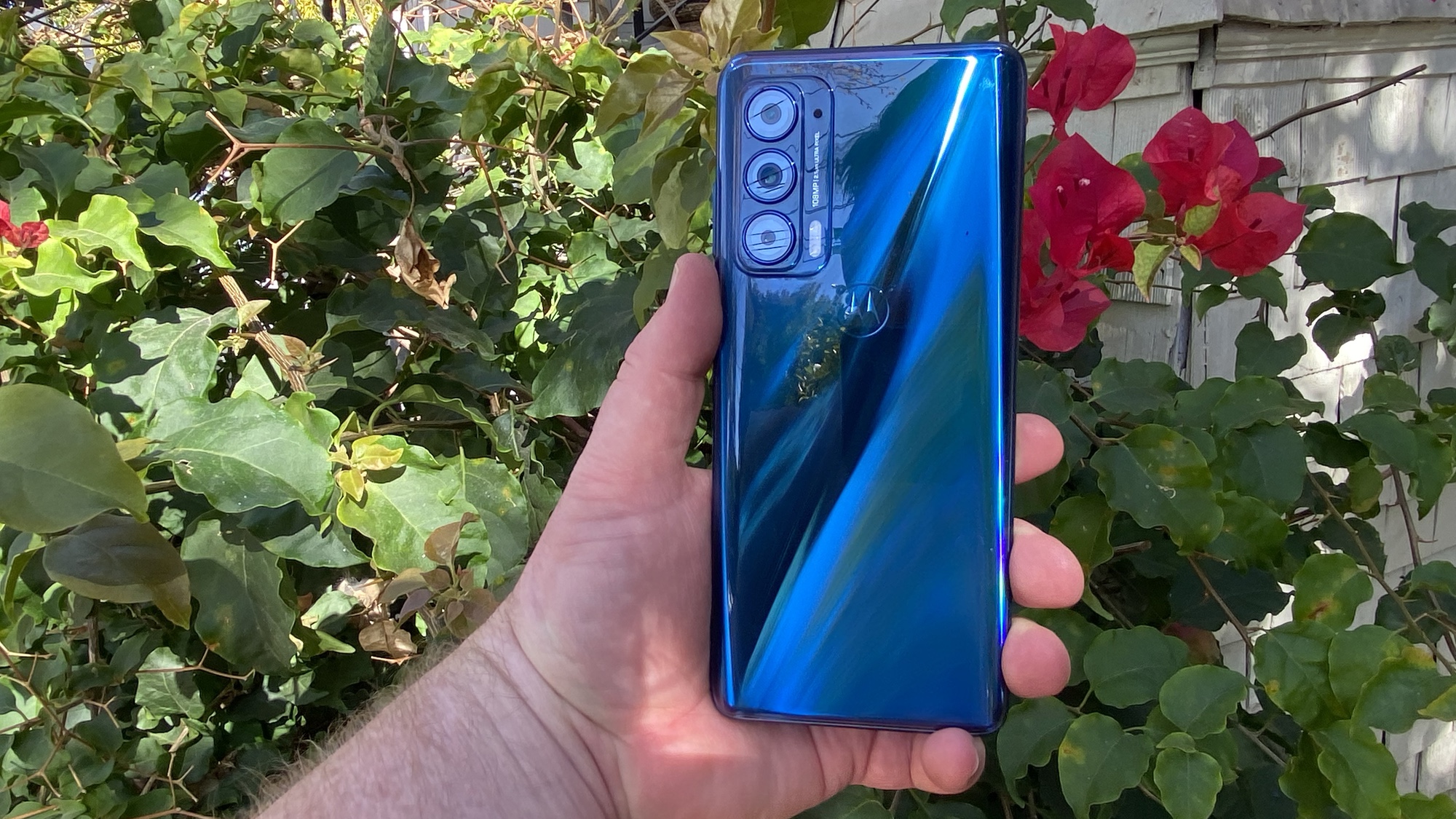
The Motorola Edge houses its fingerprint sensor on the side power button, which is responsive enough when it comes to unlocking the phone. If I have any objections, it's that the power button is built a little too subtly into the right side of the phone, so that it can take some time sliding your finger up and down the side to find it. The power button is also pretty close to the volume toggle, so you could wind up adjusting volume when all you want to do is unlock your phone.
This is a fairly large phone so that it can accommodate the Motorola Edge's 6.8-inch display. Unlike the edge-to-edge screens in vogue these days, there's a noticeable bezel at the bottom of the Edge's LCD panel, presumably to house the phone's speaker. With a punch-hole cut-out at the center of the display, don't expect a lot of encumbered screen real estate, despite the Motorola Edge's size.
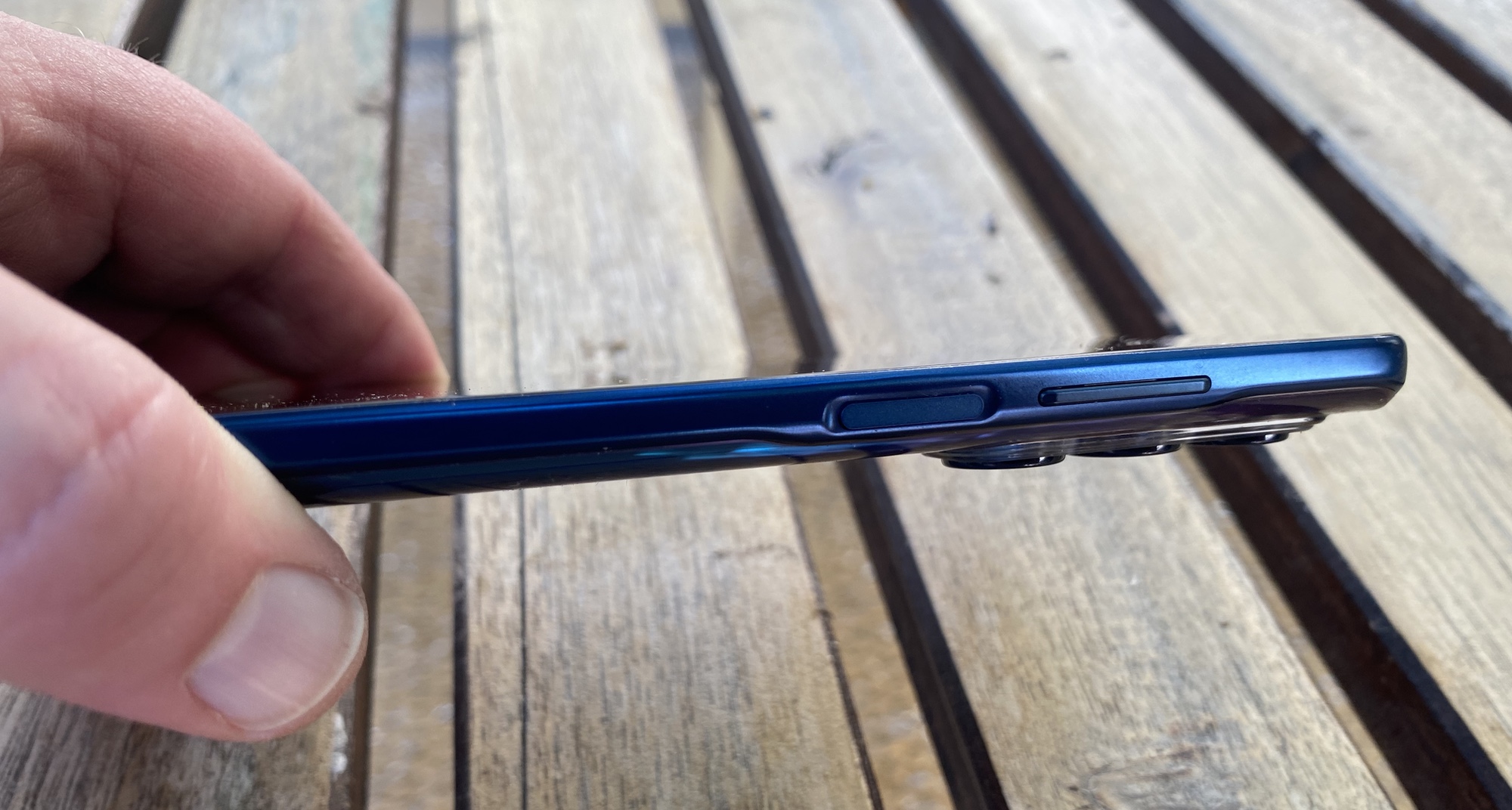
On the back of the phone, the three rear lenses on the Motorola Edge jut out, with multiple layers on the camera array itself. The end result is that the Motorola Edge 5G UW doesn't lay flat on its back — the pronounced camera array means it will always wobble.
Motorola Edge 5G UW review: Display
As noted above, the Motorola Edge features an LCD panel — an odd choice given the number of similarly priced phones that feature an OLED screen. Still, that doens't stop the Motorola Edge from picking up the vibrant colors of the Encanto trailer when I streamed it on YouTube or from handling the multicolored battle between Ultron and the Guardians of the Multiverse when I streamed the season finale of What If…? on Disney Plus.
Our test numbers bear this out. The LCD panel of the Motorola Edge captured 123% of the sRGB color spectrum in saturated mode and 104.2% of that same spectrum in natural mode. That compares to 119.3% on the Google Pixel 5a. The screen on the Galaxy A52 5G is more colorful — in vibrant mode, it shows off 201.35% — but the colors are slightly more accurate on the Motorola panel. The Edge has a Delta-E rating of 0.21 to the Galaxy A52's 0.22 result. (Numbers closer to zero are more accurate.)
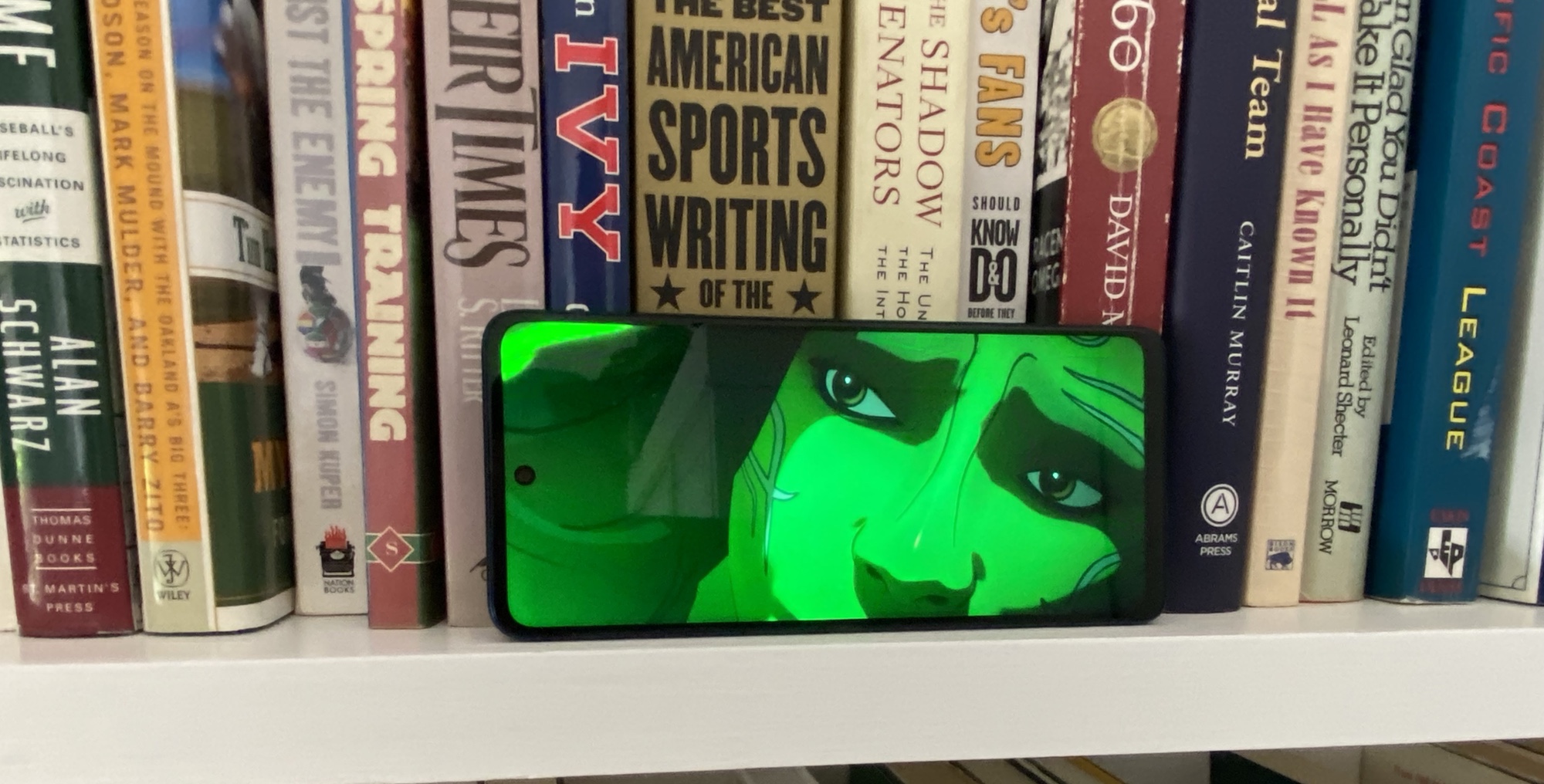
You're not getting a very bright panel with the Motorola Edge 5G UW, which we measured at 507 nits with adaptive brightness turned on. That's slightly brighter than the Pixel 5a (501 nits), but well behind the Galaxy A52 (708 nits) and iPhone 13 mini (788 nits).
The true highlight of the Motorola Edge 5G UW is the phone's adaptive refresh rate, an increasingly common feature among phones in this price range. But while a lot of phones top out at 120Hz, the Motorola Edge is capable of reaching 144Hz — a refresh rate more common among the best gaming phones. You could argue that this is overkill — to the naked eye, screens scroll as smoothly at 120Hz as they do at 144Hz. Nevertheless, this is a welcome addition that adds to the Motorola Edge's value.
Motorola Edge 5G UW review: Cameras
Motorola makes a big change with the main lens on its new phone. While last year's Motorola Edge featured a 64MP sensor, the Motorola Edge 5G UW offers a 108MP wide angle camera — the kind of spec you normally see on a much more expensive phone like the Galaxy S21 Ultra. The Edge's other rear cameras are comparatively ordinary — an 8MP ultrawide angle lens with a 119-degree field of view and a dedicated 2MP depth sensor.
By default, the main camera captures 12MP photos, but you can tap into settings to switch to Ultra Res mode for photos at full resolution. You can see the difference in these images of Halloween decorations — one shot with the Edge's default settings and the other in Ultra Res mode; the colors of the Ultra Res photo are richer, particularly around the flower petals. While this also gives the photo a darker cast, the shot still looks more vibrant, with greater depth. You wouldn't want to shoot at full resolution all the time — the pictures take up quite a lot of space — but it can really bring out the colors of a scene.
I shot some other photos using the iPhone 13 as a comparison. Perhaps that's not the fairest of fights — Apple's $799 device is one of the best camera phones around. But the side-by-side shots do give you a sense of how far the Edge's photo capabilities have come since the disappointment of last year — and the work that still needs to be done.
Sticking with those decorations for a moment, the Motorola Edge's shot in its default mode compares well to the iPhone 13's effort. That said, the iPhone 13's image-processing smarts bring out more of the colors and handle that glass jar in the background with greater aplomb. There's too much of a glare off the jar in the Motorola Edge's photo, and it detracts from the overall shot.
Moving inside to a not terribly well lit plate of Chinese takeout, the Motorola Edge bathes its photo in cool tones. The shot is OK, but it lacks the warmth and definition of the iPhone 13's photo, where the orange chicken glistens, and you can make out char marks on the strips of onion. The iPhone's colors are accurate, too — an issue that came up again and again when testing the Motorola Edge 5G UW's cameras.
The coolness continues at night, where the Motorola Edge's Night Vision mode captures the apples on a table lit only by an overhead light. But the apples look a little fuzzy around the edges, which can happen when there's not a lot of light to go around. Here, we see the advantage of Apple increasing the size of the iPhone 13's sensor to let in more light. The iPhone photo is not only sharp, but also colorful, as you can make out the different shades of color for each apple — a detail lacking in the Motorola Edge picture.
I went down to the shoreline to try out the Motorola Edge's ultrawide angle camera, and here I think Motorola's phone is on more equal footing with the iPhone 13. It's the Motorola image that actually has the more pleasing color this time around, at least in terms of accuracy.
The iPhone expends a lot of energy pumping up the blue in the sky, and that's to the detriment of the other objects in the frame. I certainly think that Coast Guard ship far in the distance stands out a little more in the Motorola Edge photo.
Speaking of that Coast Guard ship, I zoomed in on it to see how the digital zoom looks on both phones. (Neither the Motorola Edge nor the iPhone 13 offers a dedicated telephoto lens.) Motorola's phone produced the crisper shot, with the edges of the ship sharply in focus. Things are a little fuzzier on the iPhone 13 at a 3x zoom.
For a phone with a dedicated depth sensor, the Motorola Edge's portrait shot of my daughter disappoints. The image itself is OK, though my daughter's skin looks a little pale and washed-out in the photo. It's the half-hearted blur that mystifies here, with the bush behind my daughter and the tree she's leaning against only haphazardly blurred. The result looks more random than artistic. Contrast that with the iPhone 13, where the blur is consistent throughout, and the warmer skin tones are better rendered.
On the other hand, the 32MP selfie cam on the Motorola Edge 5G UW produces some fine self-portraits, at least when compared to the iPhone 13's output. My skin looks very natural in the Motorola shot, and there's not a lot of evidence that the photo-processing software tried vainly to pretty me up. The iPhone, on the other hand, emphasizes the ruddiness in my complexion. It's a warmer portrait, but not necessarily a more accurate one.

In addition to those lenses, the Motorola Edge 5G UW has a few other photographic tricks up its sleeve. There's a macro option right next to the buttons for switching between the main and ultrawide lenses. Enable macro mode and you can get up to 2cm away from your subject matter — in this case a rose that looks very detailed in the Motorola Edge's photo.
On the video front, you can capture 4k video at 30fps with the rear lens and you can shoot slow-motion video in Full HD at 120 fps. But I think the more impressive feature is a dual-camera mode that shoots from the rear and front cameras simultaneously. The feature's sure to win the hearts of video bloggers, especially given how easy it is to toggle between the two shots.
Motorola Edge 5G UW review: Performance
The Snapdragon 778G system-on-chip inside the new Motorola Edge isn't the most powerful one by Qualcomm, but it does offer more muscle than some of the other chips in Qualcomm's 7 Series. To that end, on Geekbench 5, the Motorola Edge turned in a single-core result of 764 and a multicore result of 2,716. That's ahead of the respective results of 637 and 1,866 turned in by the Galaxy A52 5G and its Snapdragon 750G chipset. Really, the Motorola Edge 5G UW's numbers are more in line with the Galaxy S20 FE, which produced a 2,928 multicore score on Geekbench with older Snapdragon 865 silicon.
In terms of graphics test results, the Motorola Edge once again outperformed phones with less powerful Snapdragon Series 7 chipsets like the Galaxy A52 and Pixel 5a (which uses a Snapdragon 765G). In 3DMark's Wild Life Unlimited, the Motorola Edge 5G UW managed to produce a result of 14.8 frames per second, topping the respective 10 fps and 6.6 fps results for the Pixel 5a and Galaxy A52.

That translates to some solid if not spectacular performance on the Motorola Edge 5G UW, as I used the phone in everyday tasks. Apps launch promptly enough, and I had no trouble switching between open applications. Graphically intensive games like Asphalt 9 and PUBG Mobile performed well on the Motorola 5G UW, though I noticed a couple of stutters when tracking the movements of my teammates on the latter game.
My biggest objection to gaming on the new Motorola Edge, though, has nothing to do with performance, but more to do with sound. The phone features a single speaker on the bottom, and when you're holding the phone in landscape mode, chances are good your hand will cover that speaker. That leads to muffled sound, and on a game like PUBG Mobile, where you have to listen for your enemy's approach, that can mean an untimely demise.
As noted, the version of the Motorola Edge I tested works with Verizon's Ultrawide Band 5G network. That's only available in portions of 87 cities as of this writing, though Motorola's slower nationwide 5G has a broader reach. Alas, that does not include my house, indicating that the much ballyhooed benefits of 5G remain elusive for some users at this point.
Motorola Edge 5G UW review: Battery life and charging
Fast-refreshing displays can put a serious hit on battery life, and we see that with the Motorola Edge 5G UW's 144Hz refresh rate on its 5,000 mAh battery. When that mode is enabled, the phone produces very pedestrian times on our battery test, in which we have a phone continuously surf the web over cellular until it runs out of power.
When the display was set to 144Hz, the Motorola Edge 5G UW lasted 9 hours and 23 minutes, which is a little more than half-an-hour shorter than the average smartphone. Set the refresh rate to 60Hz, though and times improve dramatically. At 60Hz, the Motorola Edge can hold out for 11 hours and 38 minutes — good enough for a spot on our list of best phone battery life. We'd recommend setting the phone's display to automatically adjust its refresh rate, which will let you enjoy smoother scrolling without the hit on battery life that comes when you lock in the phone at 144Hz.
| Header Cell - Column 0 | Battery size | Battery life (Hrs:Mins) |
|---|---|---|
| Motorola Edge 5G UW | 5,000 mAh | 11:38 (60Hz); 9:23 (144Hz) |
| Samsung Galaxy A52 | 4,500 mAh | 12:19 (60Hz); 10:19 (120Hz) |
| Google Pixel 5a | 4,680 mAh | 9:45 |
| iPhone 13 mini | Unknown | 8:54 |
| Samsung Galaxy S20 FE | 4,500 mAh | 9:03 |
At least the Motorola Edge lasts longer than the iPhone 13 mini (8:54) even with that battery-draining 144Hz mode enabled. The Edge's battery test result is just a shade behind the Google Pixel 5a's time of 9 hours and 45 minutes. Among comparable phones, the Galaxy A52 outperforms the Motorola Edge, though it too sees its time drop when you enable the display's faster refresh rate.
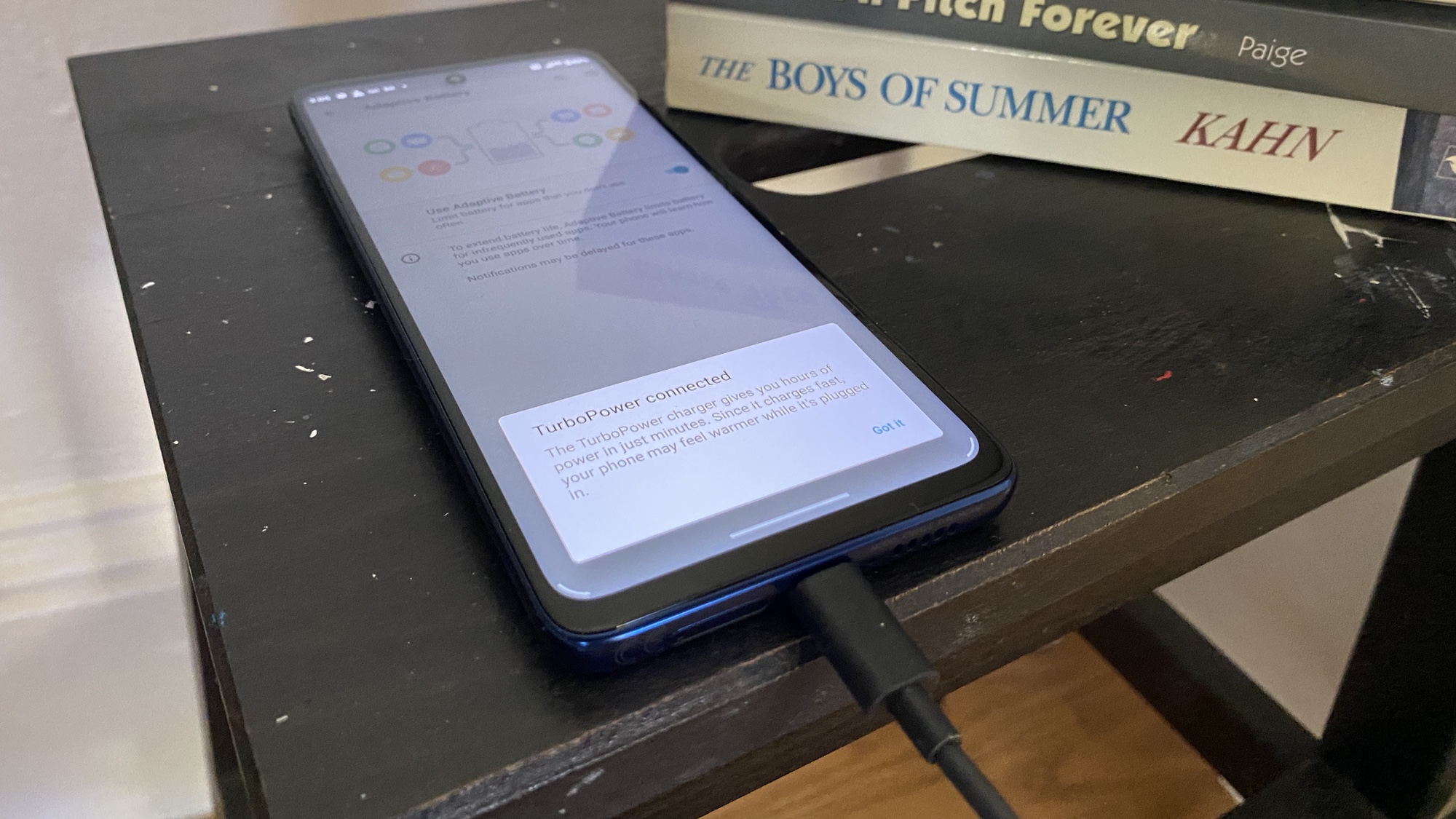
Motorola has equipped this year's version of the Edge with 30W TurboPower charging, which promises speedy recharging. Using the charger that came with the Motorola Edge, we got a drained phone back up to 56% charge after 30 minutes. The Pixel 5a gets up to 43% while the Galaxy A52 reaches 31% in that same time.
Motorola Edge 5G UW review: Software and special features
The Motorola Edge 5G UW launches with Android 11 installed. With Android 12 launching this month and coming to Motorola's phones at a later date, that takes care of one of the two promised software upgrades; you can also expect two years of bi-monthly service upgrades. That seems skimpy, especially at a time when Samsung and Google are offering longer support for their Android devices.
I do happen to like Motorola's My UX interface, which leaves the Android operating system largely untouched, save for a couple of useful add-ons. These include support of gesture controls such as being able to twist your wrist to launch the camera and taking a screenshot by touching and holding the display with three fingers. My UX is packed with useful shortcuts like those, but if you don't find them to your liking, you can always disable them in the Moto app.
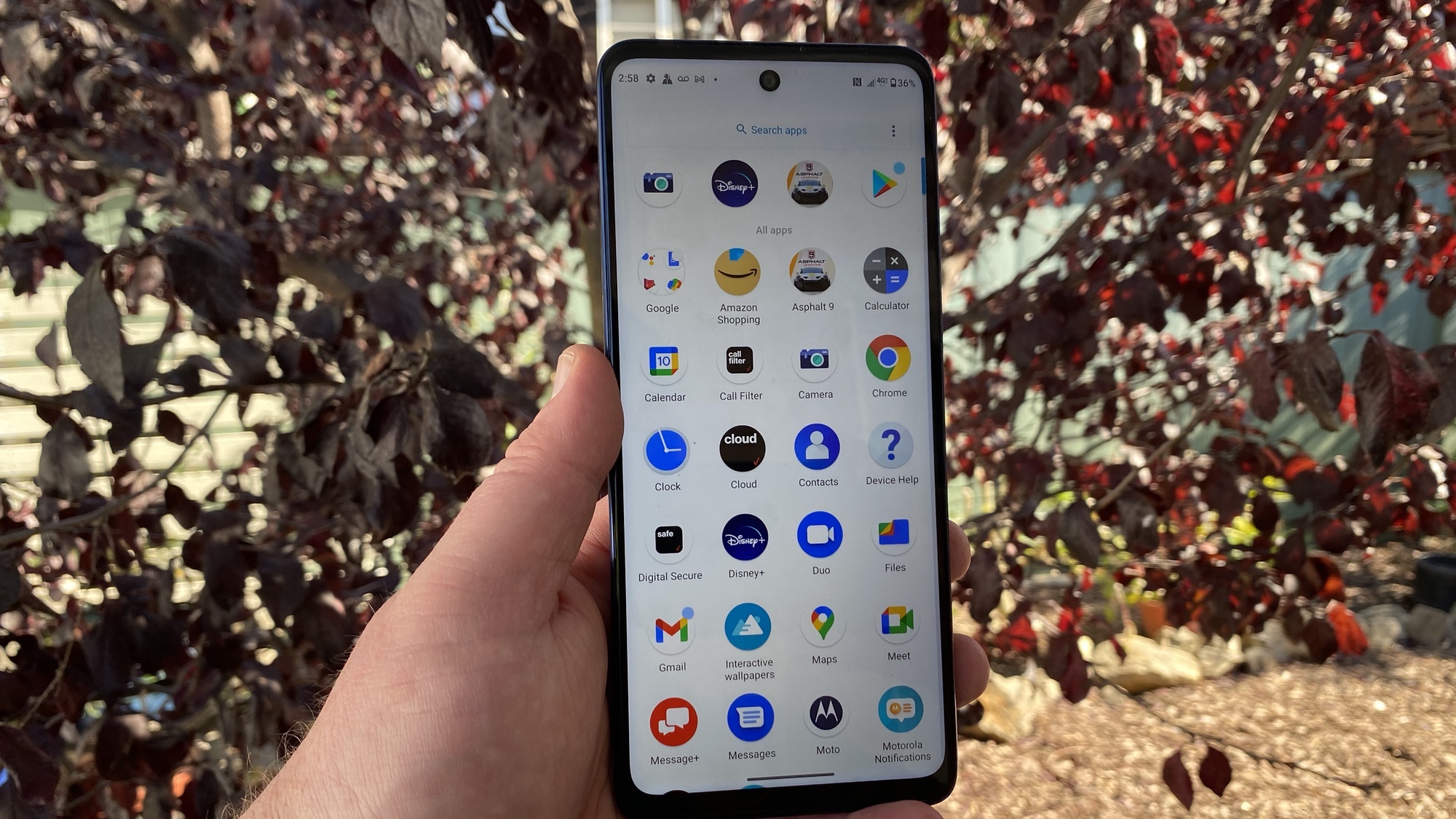
The Motorola Edge also supports Ready For, Motorola's feature for using your smartphone as a portable PC. As with other Ready For phones, the Motorola Edge 5G UW can connect to a monitor with either a USB-C to USB-C or USB-C to HDMI cable. From there, you'll get a Windows 10-style interface, letting you use your Android apps on a bigger display. My colleague Richard Priday tested Ready For earlier this year on a different Motorola phone and found it to be a work in progress, but it's a nice feature to have for productivity mavens.
Finally, this Verizon-tied version of the Motorola Edge includes Verizon Adaptive Sound, which you can find in the Sound section of the phone's settings app. Verizon Adaptive Sound is meant to make the phone's lone speaker sound more expansive. It makes a difference — audio sounds a lot deeper and richer when you've got Verizon Adaptive Sound enabled, even if it's nothing that can compete with stereo speakers.
Motorola Edge 5G UW review: Verdict
If you've overlooked Motorola's higher-end phones in the past, the Motorola Edge 5G UW does a very good job at trying to regain your attention. Improvements to the main camera impress, and even if this can't topple a premium camera phone like the iPhone 13, it's a vast improvement over the previous Motorola Edge. I'm also impressed by how quickly the phone recharges.
The 144Hz refresh rate is probably a step too far, given the impact it has on what would have been solid battery life — especially when a 120Hz refresh rate would have been more than enough at this price point. I also think the lone speaker detracts from what would otherwise be an enjoyable gaming experience on an affordable phone.
It's the affordability that ultimately wins the day for the Motorola Edge 5G UW. At less than $600 for the Verizon-tied version — and only a little bit more for the unlocked Motorola Edge (2021) — this phone offers enough premium features to put it at the forefront of midrange options. If you're looking for high-end features without a correspondingly high price tag, make sure that the Motorola Edge 5G UW is on your shortlist.
Philip Michaels is a Managing Editor at Tom's Guide. He's been covering personal technology since 1999 and was in the building when Steve Jobs showed off the iPhone for the first time. He's been evaluating smartphones since that first iPhone debuted in 2007, and he's been following phone carriers and smartphone plans since 2015. He has strong opinions about Apple, the Oakland Athletics, old movies and proper butchery techniques. Follow him at @PhilipMichaels.


